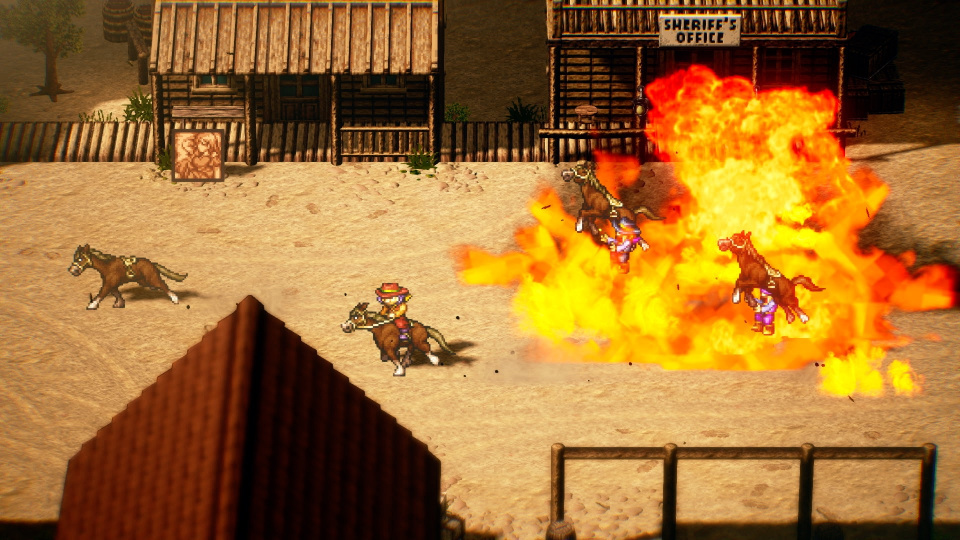Live A Live Test | GamersGlobal.de
teasers
Almost 30 years after the Japan-exclusive SNES launch, Square Enix is giving its JRPG a remake on the switch. The rejuvenation is technically successful, but what about the gameplay?
 |
All screenshots and video scenes are from GamersGlobal
I could think of a number of games that I’m not the only one wishing for a remake. The modernized remake of an RPG released in 1994 only in Japan isn’t high on my personal list, though. With Square Enix and some JRPG fans, however, things seem to be different. Because now, almost 30 years after the original launch on the Super Famicon, a remake of Live A Live exclusively for Nintendo Switch, making the game available in the West for the first time. I played the adventure remake distributed under the same name for you. You can find out here and in the test video embedded above whether the episodic concept with eight characters in different settings and in different epochs inspired me or rather sobered me and whether I can fully recommend it to genre fans.
 |
| In the “Near Future” chapter, you board this titan and use it to effortlessly dismantle multiple tanks at once. |
Seven times ready at any time
The greatest feature of Live A Live is clearly the episodic concept. In each of the seven chapters that are available from the start, you take on the part of a different character and end up in a completely different setting at a completely different time. You unlock new sections as you progress through the game. Among other things, it goes with a gunslinger in the Wild West, as a furry warhorse in the Stone Age or as a robot on a research spaceship. The chapters are initially independent of each other in terms of narrative, but are later interwoven with each other in terms of content. How exactly, you are welcome to find out for yourself.
Apart from the setting, or the underlying epoch, there are also game mechanics differences. Only the up-and-coming ninja of the Edo era can turn invisible at the push of a button, easily bypassing most enemies without fighting. The caveman, on the other hand, has a particularly keen sense of smell, with which he can sniff out the tracks of wild animals, but also hidden secrets in the area. More important, however, are the generally different focuses of gameplay. In the “near future”, for example, the more or less JRPG-typical fights are much more central. The shinobi sometimes has to crawl around in attics, solve small switch puzzles or find keys for gates.
That spontaneously sounds like a great variety. However, that really only applies to the underlying timelines and superficial gameplay differences. The predominantly quite short chapters are mostly rather monotonous on their own. So you mostly do the same things in it, which can get boring after a short time. The possibility of interrupting a chapter at practically any time and being able to continue with another first is only a theoretical remedy.
 |
| The Western section is comparatively story-heavy. As is typical for JRPGs, there is hardly any fighting, instead an essential part of the chapter consists of preparing an ambush for the “Crazy Bunch”, which then runs automatically. |
Limited JRPG joys in battle
Live A Live is clearly a Japanese RPG with basically everything that entails – and even a few peculiarities, apart from the episodic form. What I mean by that is that there are a number of skills for main heroes and any companions that can only be cast in rather unusual patterns on the chessboard-like battle arenas. So you can only use them diagonally, even if that’s not necessarily logical. Of course, each character has their own skills, which are expanded by leveling up, you can optionally create better weapons, armor parts and so on. As usual, there are also consumables for healing or offensive stuff like hand grenades.
Live A Live is still more of a JRPG light in terms of combat. You can die, and as is typical for the genre, level grinding is the order of the day in at least one chapter, since the story opponent there is otherwise almost impossible to defeat. Outside of the big fights, however, there really is always the possibility of escaping – which, at least for me, has never failed. Since then all negative status effects, lost hit points and so on are reset, the claim is correspondingly low. However, that also has its good side, because there are no selectable levels of difficulty, and then I’d rather be under-challenged than over-challenged…
 |
| Square Enix finds a good mix of retro charm and modern technology. Here there is, similar to in Octopath Traveler, pixelated look in HD and often diorama-like environments. Here you can see the shinobi during the Edo period. |
Stylish HD pixel graphics
From my point of view, the greatest strength of Live A Live is the atmosphere. Anyway, I really like the pixel look graphics. Also the diorama-like style of the environments, which is not accidental Octopath Traveler remembered is a feast for the eyes. The soundtrack is also very nice, which also finds a good hybrid of modern sounds and MIDI sounds, of course in much better quality. As a big fan of spaghetti westerns like Two glorious scoundrels or My name is Nobody as well as especially the music of Ennio Morricone, I feel pretty comfortable with the gunslinger chapter too. For my taste, however, the jaw harp should be heard more often – or did I just imagine it?
Humor is at least as important for the atmosphere. It doesn’t come into its own in all chapters, although there are even running gags. It may not sound funny that the father of a father-son duo who appears several times always dies, but it is nonetheless. Ask south park-Fans after Kenny. I found the Stone Age section particularly amusing. The content of the conversation conveyed in symbols made me smile again and again. Incidentally, they were used because the primeval humans cannot speak. Otherwise most of the dialogues are set to music in English and Japanese. However, I really threw myself away in an early scene in which my club swinger meets a Stone Age woman, falls in love with her and engages in non-verbal communication (also in the form of kicks and punches towards his monkey-faced roommate) that at least players with a similar penchant for slapstick and comic violence as I do, will certainly find it just as good. It’s a shame that the rest of the game doesn’t reach this level.
Author: Benjamin Braun, Editor: Dennis Hilla (GamersGlobal)

Opinion: Benjamin Brown
I didn’t know the original Live a Live, so I don’t know in detail what happened with the remake. Still, it’s hard for me to imagine that Square Enix couldn’t have found another title in its rich portfolio more deserving of a remake. With the many different heroes and settings, the JRPG is certainly something special. That or the different game mechanics alone are not enough for me to make it a compulsory title.
That’s not to say that Live a Live is a bad game – I had a lot of fun with it. It’s just not really good either, in any case far from the fact that I could make a general purchase recommendation. In fact, I would highly recommend even JRPG friends to play the eShop demo. Because the probability that she disenchants the promising concept for you is at least as high as that she fixes you.
Live A Live
Entry/operation
- Almost always helpful target marker
- All important functions well explained
- Escape (outside of story fights) almost always possible
- Convenient auto-save function and lots of manual save slots
- You can change chapters at any time
- No difficulty levels (overall very easy)
Game Depth/Balance
- Seven different settings in different epochs
- Each chapter with special game mechanics
- Interesting main and secondary characters
- Lots of references to other games and movies
- Quite humorous (especially Stone Age section)
- Within the respective chapter partly monotonous gameplay
- Mostly too easy, but rarely requires grinding
- Self-running sequences partly staged moderately (longer waiting times until it continues)
Graphics/Technology
- Nice pixel look graphics partly in diorama style
- Nice effects and animations
- Too many, albeit short loading times
Sound/Speech
- Atmospheric soundtrack, mostly fitting to the setting
- Good English and Japanese speakers
- No German voice output
multiplayer
Unavailable
6.5
microtransactions
no
hardware info
- Mouse keyboard
- gamepad
- steering wheel
- Other
- Oculus Rift
- HTC Vive
- PlayStation VR
- Other
- Steam
- Copy protection-free GoG version
- Epic Games Store
- uPlay
- Origin
- Manufacturer Account Connection
- Constant internet connection
- Internet connection at startup
Reference-www.gamersglobal.de